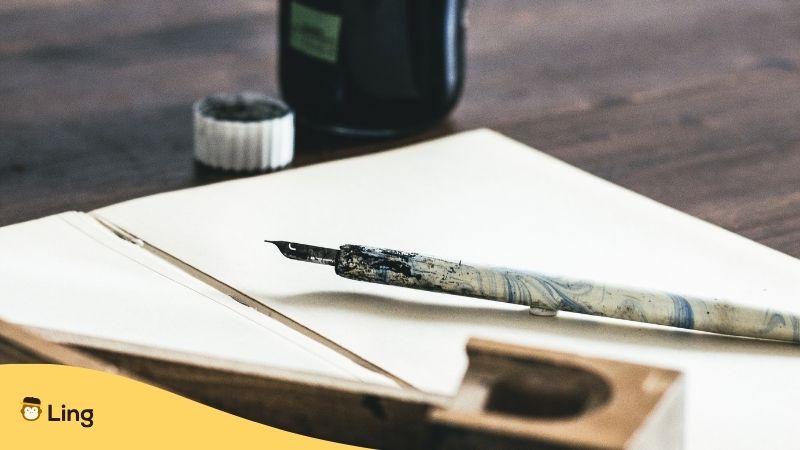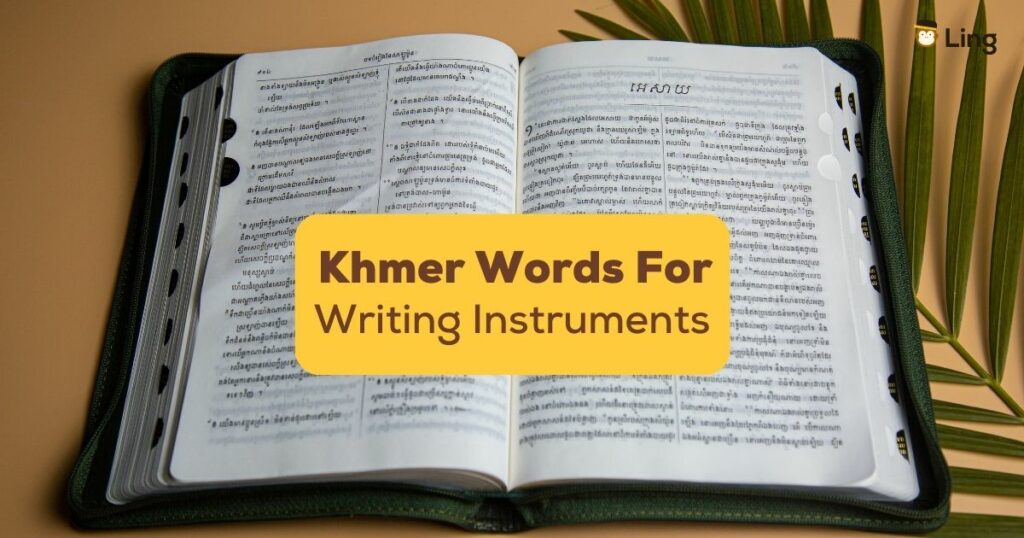The Khmer language has a unique script and a distinct set of words and phrases related to writing instruments and techniques.
In this blog, we will delve into the fascinating world of Khmer words for writing instruments and explore some traditional Khmer writing techniques that have been passed down through generations.
Khmer Words For Writing Instruments
In Khmer, a language rich in cultural history, words for writing instruments are infused with tradition. “មន្ទីរ” (mantii) denotes a quill or pen, evoking images of ancient scribes. “ខេត្ត” (kahte) represents ink, harking back to the days when manuscripts were meticulously crafted.
Pen: Bic (ប៊ិច)
The Khmer word for pen is “Bic”. Although traditionally, Khmer pens were made from natural materials such as bamboo or reeds often sharpened at one end to create a fine point for writing, the term Bic is far more modern. You’ve already guessed where it comes from.
Hungarian László Biró may have invented the ballpoint pen to replace the fountain pen (ប៊ិចប្រភព), but it was French entrepreneur, Marcel Bich who recognised the potential and began mass producing what is now the best selling pen on the planet. Which means nearly everyone already knows the Khmer word for pen.
Ink: Tuk Thnam (ទឹកថ្នាំ)
The Khmer word for ink is “Tuk Thnam.” In traditional Khmer writing, ink was an essential component. It was prepared by mixing various substances like charcoal, gum Arabic, and water. The resulting ink was used to write on palm leaves or special paper made from the bark of the mulberry tree.
Paper: Kradeas (ក្រដាស)
Khmer paper often referred to as “Kradeas,” was traditionally made from the bark of the mulberry tree. The process involved stripping the bark, soaking it, and pounding it into thin sheets. This paper was used for important documents, manuscripts, and religious texts.

Quill: Khvil (ឃ្វីល។)
The quill pen, or “Khvil” in Khmer, was another writing instrument used in ancient Cambodia. Quill pens are crafted from the feathers of various birds that have a hollow shaft down which the ink flows and provides a smooth and elegant writing experience. The bird feather quill was often paired with homemade ink to create beautiful calligraphy.
Writing Brush: Chik Sarser (ជក់សរសេរ)
While reed pens and quills were more common, the Khmer also used brushes as writing implements. The Khmer word for writing brush is “Chik Sarser.” These brushes, such as horsehair or goat hair, were typically made from animal hair and were employed for intricate and artistic writing styles.
Khmer Writing Techniques
Here is a rundown in the Khmer writing techniques and corresponding instruments.
Palm Leaf Manuscripts: Sastra Sleuk Rith (សាស្ត្រាស្លឹករឹត)
Traditional Khmer writing was often done on palm leaves called Sleuk Rith. These leaves were dried for at least a month and cut into rectangular or square shapes, bound together with cords, and given another few days of smoke treatment in order to make them durable enough for a blade. The characters were etched onto the palm leaves with a pointed stylus. It is thought that the technique dates back to the 5th century BCE in southeast Asia when sacred Buddhist texts known as Preah Trai Bekdok (ព្រះត្រៃបិដក) in Khmer were inscribed into the leaves.

Engraving: Kar Chhlak (ការឆ្លាក់)
“Kar Chhlak” is engraving characters or designs onto hard surfaces. This method was commonly used for creating inscriptions on stone tablets, temple walls, and other architectural elements. Khmer artisans would carve intricate scripts and decorative motifs into stone and Khmer inscriptions the only form of writing left over from the Khmer civilisation that we can learn about these ancient peoples from.
Calligraphy: Aksar Ophchang (អក្សរផ្ចង់)
Calligraphy, or “Aksar Ophchang,” is an essential aspect of Khmer writing culture. Skilled calligraphers would use various scripts, such as the Khmer script or the ancient Pallava script, to create beautiful and artistic texts. Calligraphy was often employed in religious texts and royal decrees. There are two main styles which are Aksar mul (អក្សរមូល) “round script” and Aksar chrieng (អក្សរជ្រៀង) “slanted script”.
Punctuation Marks: Sanhnhea Vonnayoutte (សញ្ញាវណ្ណយុត្តិ)
Proper punctuation is crucial in writing, and Khmer writing, because there are not usually gaps between words, has its unique set of punctuation marks known as “Sanhnhea Vonnayoutte.” These marks help indicate the rhythm, flow, and pronunciation of the text, making it easier for readers to understand the intended meaning.
From the traditional pens and inks to the intricate calligraphy and engraving methods, the Khmer people have developed a unique and artistic approach to writing. Despite the advent of modern technology and digital communication, these traditional writing practices continue to be an integral part of Khmer culture, preserving the beauty and elegance of the Khmer script for generations to come.
Continue Your Khmer Calligraphic Adventure With Ling
The curls and twirls of the Khmer script can seem like insurmountable hieroglyphs when you first start to learn the language of Cambodia. However, with Ling you will be provided with bite-sized lessons to help you get to grips with the script quickly and easily. Ling’s tracing tool means you will be shown how to write the Khmer alphabet from your very first lesson and will soon be stringing those letters into words and those words into sentences.
Being able to read a language is essential if you want to become fluent and the strange shapes of the Khmer script will soon start to form into letters as recognisable as the alphabet of your native tongue. As well as learning how to read and write, Ling app will soon have you conversing like a native as you learn from real Khmer speakers and practice whenever you have the time with Ling’s AI chatbot. There’s no better time to start learning a new language with Ling app than today, so why not check Ling out now at the App Store or Google Play?



































































